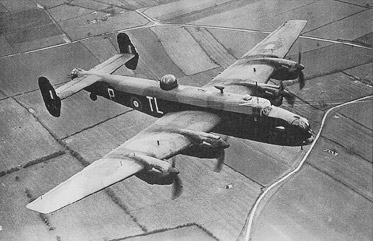|
The Handley Page Halifax Mark II 
The Handley Page Halifax was the third of four long range bombers developed for the RAF in World War Two. In size and performance it was a major advance up from the earlier two engine Vickers Wellington or the low performance four engine Short Stirling. The Halifax was 22.5 metres long, with a wingspan of 31.7 metres. The Mark II was powered by four Rolls Royce Merlin XX or XXII engines, each producing 1500 hp. Maximum airspeed was 450 kph, with a maximum altitude of 6400 metres. It had a bomb load of 5400 kg and a range of 2000 km - sufficient for missions anywhere in Germany or occupied France. The Mark II had a seven man crew: pilot, co-pilot, wireless operator, navigator/bombardier, flight engineer, dorsal gunner and rear gunner. Its defensive armament included a single machine gun in the nose, a four gun power turret on top - the dorsal position - and a four gun power turret at the back - the "tail-end Charlie". Despite its superiority over the Wellington or the Stirling, the Halifax had a poor reputation as an operational aircraft. One problem was that the aircraft was underpowered. The engines available at the time were not able to produce enough power to overcome the plane's weight - especially as more and more features were added. Fully loaded Halifaxes needed extremely long runways to build up enough speed for lift off. The limited engine power also gave the Halifax poor climbing performance, a maximum airspeed 160 kph below that of German fighters, and a maximum altitude of 6400 - still within the range of high performance German anti-aircraft guns. The engines for the Halifax were mounted too close to the wing bringing the propellers very close to the leading edge of the wings. The high thrust line disturbed the airflow over the wing, causing loss of lift, while the proximity of the propellers to the wing's leading edge interfered with the efficiency of the propeller blades, causing heavy vibration, and premature engine wear. The most serious problem of all, however, was that the plane's twin rudders , when exposed to violent maneuvers, had a tendency to overload and jam, making it possible for the Halifax to enter an inverted and uncontrollable spin. At low altitude this problem almost always resulted in the plane crashing, with the crew killed. Fortunately these problems were corrected with a changed rudder design and the addition of more powerful engines in the Mark III. Despite these problems the Halifax Mark II and Mark III remained the main aircraft used by RCAF No. 6 Group, the RCAF component of bomber command. Few RCAF squadrons received the far superior and legendary Lancaster bomber until late in 1943 
Here are two film clips on the Halifax bomber: Halifax Bombers In The Making (1942) 1:27 Handley Page Halifax in Colour 2:17 |